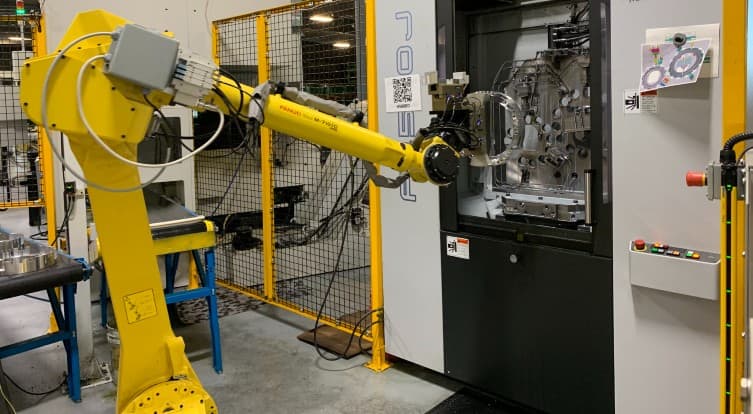At some point, we all need some help with the heavy lifting.
For CNC machine shops, that can mean robots to lift, position, and pack metal castings, some weighing hundreds of pounds. It also means less physical and mental stress on employees, the most valued asset of any machine shop.
Working alongside a robot can improve operator productivity by taking on repetitive, physically demanding work. CNC robotics increase speed, enhance efficiency, and drive repeatability, which leads to better quality.
CNC manufacturing robots can perform many tasks, reducing physical stress on shop workers.
Tip #1: Explore Functions Performed by Robots
Using robotics, many manufacturing processes can be updated to automate high-volume work. What can machining robots do? Well, with the right design and proper programming, they’re incredibly versatile. Industrial robotics in a CNC machine shop environment typically takes on simple but important tasks.
9 Tasks. 1 Robot.
Here’s an example of nine tasks, all performed in this order (and the same every time) by a single robot:
- Locate and orient a casting in a dunnage using a vision system
- Grab it and pick it up
- Blow off fixture to remove any chips prior to loading
- Load it into a CNC machine for cutting
- After machining, blow off part and drain coolant back to machine
- Unload the machined part
- Deburr the part (remove sharp edges and burrs left from machining)
- Wash the part by loading and unloading in a washer
- Place the part on an outbound conveyor
Although these are nine individual steps, it’s a very simple example. A robot can also apply a data matrix on a part for tracking; can sample parts for quality audits; and, if there are multiple parts, the robot keeps track of them without mixing them up.
Let’s explore the different functions of a robot:
- Picking up parts — Parts can be picked from dunnages, conveyors, stands, and fixtures. When parts aren’t placed repeatedly, like in a dunnage or on a conveyor, vision systems are used to locate and orient parts before they are grabbed and lifted
- Flipping/manipulating/moving parts — A robot can flip a part around or set it on a stand and regrip it from the backside with another grip/tool
- Loading and unloading — Robots load and unload parts into/onto many places: fixtures within a CNC machine, queue stands, washers, pressure testers, conveyors, finished goods containers, operator stands, coordinate measuring machines (CMMs), etc.
- Blowing off — Some robots blow metal chips and coolant off a part and fixture; chips are removed and recycled, coolant returns to the tank for re-use
- Deburring — Robots can remove sharp edges that remain after machining
- Diverting parts — If two similar parts are being made, the robot keeps them separate and also samples Nth part for a quality check; defective parts (from a failed pressure test, for example) can be automatically segregated to be removed for analysis and quarantine
- Tracking parts — Robots hold a part to a direct part marker (DPM) to receive a data-matrix mark and hold it to a reader to verify the mark and track the part
- Packaging — Robots pack parts and manipulate packaging materials. Using air suction cups, robots pick up and place plastic layer pads between vertical layers of parts. For larger parts (engine covers, for example) a plywood divider is placed using a stronger air-foam grip
- Queuing — Robots queue input, in-process, and finished parts, keeping the machines running and removing the need for workers to pack one part at a time
Tip #2: Know Robot Programming
How do robots know how and when to perform all of these functions? Robots are “taught” motions and behavior as a sequence of points and functions; they’re programmed. For instance, a CNC operator jogs a robot’s arm throughout an operation, teaching the points, and then the robot repeats it over and over. Operations can update robots to adjust to changes and issues without relying on engineering.
The most challenging part is setting up an entirely new robotic manufacturing cell, which involves logic expertise, many functions and subfunctions, input and output, part tracking and manipulation … and a lot of engineering and expert programmer experience.
All of that work makes the initial implementation cost of using machining robotics quite high: the robot itself, front-end design, choosing the right grippers, programming the robot, determining how the robot is going to fit into established processes, etc. It requires significant upfront work to accomplish those tasks.
CNC robotics programming requires logic expertise and expert engineering experience.
Tip #3: Review Your Unique Situation Before Adding a Robot
Look at your goals for staying competitive. To accomplish them, do you need to lower production costs and/or increase productivity? Think about how adding a robot — versus adding numerous employees — can make them happen.
Next, think ahead. Do your upcoming projections include many repeatable, physically demanding projects (heavy lifting, such as loading and moving castings)?
Be patient and plan properly. Lead time for a robot delivery could be 8 months or longer. That’s not significantly more than a CNC machine, but it still could bottleneck your plans.
A CNC machine shop with engineering expertise on staff is best suited for working with a robotics distributor and introducing robotics into the shop. Having tasks well defined — the shop handles engineering challenges; the robotics supplier handles issues directly related to the robot — keeps production moving.
Lastly, what other new technologies can improve CNC machining production processes? Can artificial intelligence (AI CNC machining) work hand-in-hand with CNC robotics for more productivity gains?
Learn more about the importance of precision machined parts from our resource: CNC Machining Industry Guide.
Tip #4: Understand the Difference Between CNC Machines & Robots
Let’s briefly compare CNC machining centers to CNC manufacturing robots.
CNC machines are highly automated, standardized cutting machines designed for precise machining: milling, drilling, boring, reaming, threading, etc. using spindles that spin up to 15,000 RPMs. A robot doesn’t have a spindle and can’t achieve exact precision, but it definitely performs repeatable actions efficiently and reliably, typically using grips, deburr tools, vision, and air.
Robots use 6-axis arms and are great for moving a part from point A to point B, while a CNC machine part and work tool geometry use 3, 4, 5, or even 6 axes.
Having a robot in a work cell provides operator flexibility. The robot can work from a queue of parts, keeping equipment running for multiple machine cycles. When done right, robots simplify the CNC operator’s job, which means operators get through the learning curve faster. In the end, this improves production team scheduling flexibility.
Speaking of labor, neither CNC robots nor CNC machines are good on their own; they require skilled operators and programmers. And, even with the influx of AI, they can’t think creatively or solve problems, and they add nothing to a CNC machine shop’s culture. So, while CNC robotics are consistently productive and require no sick time, they can't do everything.
Tip #5: Choose a CNC Machine Shop That Uses Robots
Not all CNC machine shops use robots. Smaller shops and those that specialize in low-volume, highly customized parts don’t typically use robots. CNC machine shops using robots can competitively quote projects of high volume in a long-term contract. Another advantage is how robots help eliminate staff burnout, both physically and mentally. Would you rather use a hoist to slowly lift a 90-pound part or use a robot to move it quickly and safely?
No doubt, a CNC machine shop must prioritize performing precise machining; that must be the focus. Only then should robots be considered to make manufacturing faster, less expensive, and more consistent.
In general, people are becoming more robot-friendly over time. With training and education, many CNC operators have also become experts in CNC manufacturing robots. Some have become engineers and supervisors, helping to maintain, train, and improve robotic systems.
Robots perform many repeatable actions within a machine shop, but they can’t replicate the precision of a CNC machine.
Final Thoughts on Costs, Implementation & Stecker
CNC manufacturing robots are not expensive, but integration is, with the initial process often being long and expensive. Even small changes to a line mean redesigning and repurposing robot work cells.
As an example, one project at Stecker shook out like this:
- 4 CNC Machining Centers = 75% of outsourced costs
- 2 Robots = 10% of outsourced costs
- Automation (equipment, programming) = 15% of outsourced costs
Robots were actually the least expensive aspect of that project.
As beneficial as they are, CNC robotics are inflexible, with new system setup taking 3-6 months, plus the technology is not easily repurposed. Once a line is ready, you want to take full advantage. For instance, at Stecker we’re working to improve how robots run “lights out,” with no operator for up to eight hours at a time.
Because our goal is to make high-quality parts as fast as possible, we often need to rethink our designs to be both fast and robust. Our general process is to get the CNC machines up and running, make parts, prove out machining, and then automate.
High-end CNC machine shops use CNC robotics to their fullest, but how do you know when a partnership is right? Review our guide (and nine scenarios) to see when working with a CNC expert is best. Click below for your copy.







